Relocating and Integrating Trees Across the City of Burlington
Article by Eva Pepe
The trees in Burlington do us a multitude of silent favors. They mitigate the progression of the climate crisis by sequestering carbon that would otherwise enter our atmosphere. They make it easier for us to live and breathe freely by absorbing pollutant gases and toxic chemicals. We know them, we recognize them, and in so many ways by touching, climbing, observing, drawing, breathing and listening, we can have conversations with them. Trees strengthen the sense of place felt by Burlingtonians, keeping us as grounded and rooted in the land we call home as they are. Essentially, through these ecosystem services and others, we are protected by the trees, and as such we often feel the obligation to offer protection in return.

Burlington’s 2014 Climate Action Plan is one example of the city’s commitment to combating human impacts to the environment at a local level. The plan highlights the urgency of addressing climate change and the ways in which Burlington can be a leader in enacting changes that help us meet this goal. It breaks down “addressing climate change” into over 200 specific mitigation strategies that allow us to manage and reduce our greenhouse gas emissions. The action plan is effective in exploring ways we can restructure our urban landscape to make it more sustainable through changes to transportation, development, energy efficiency, renewable energy sources, and waste reduction. However, there is significant potential for the expansion and further consideration of strategies that utilize nature based climate solutions.

Nature based climate solutions (NBS) work alongside natural systems through conservation, restoration, and natural resource management to help reduce net carbon emissions and foster community resilience to climate changes. Examples include shifting to more regenerative agricultural practices, restoration of wetlands and riparian zones, and urban reforestation. NBS, while no silver bullet, have the potential to be extremely effective. Some studies indicate that over one-third of the CO2 mitigation needed by 2030 can be provided by cost-effective natural climate solutions. The actions under the NBS umbrella that are currently proposed in the Climate Action Plan are somewhat limited, and there is only one goal specifically relating to urban forestry: plant a total of 588 trees every year while maintaining the existing tree canopy.
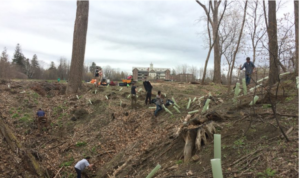
Currently there is a group of 270 young at-risk trees, many of which were originally planted between 2016 and 2019, at the park known as 311 North Avenue. 311 North Ave is one of Burlington’s newest parks and conservation areas. A very unique aspect of this park is that it is adjacent to still-evolving Cambrian Rise, the largest housing development in the history of Vermont. As a result of this proximity, there are planned disturbances to the park area. Parks staff knew there would be some tree losses, however it wasn’t until this past winter that detailed plan drawings revealed the scope at which the park disturbances would be occurring. The plans that will displace the trees are important; re-grading of the land will allow the development to extend to the property boundary, thus increasing the total number of housing units built. The construction of a paved ADA grade trail connection from Cambrian Rise to the Burlington Bike Path and the installation of a stormwater conveyance pipe will both add value to the landscape. However, due to these sacrifices that are made to meet the growing needs of our population in pursuit of a livable community, the task of finding viable new homes for the trees on this land presented itself.

Fortunately, most of the trees in harm’s way are able to be rehomed at various sites throughout the city, made available through an array of community partnerships.
- A handful of pines, burr oak and maples have been placed on the north end of Oakledge park, where they will provide a visual and sound barrier between the bike path and the nearby residential areas throughout all seasons. This section of the Englesby contains many large mature Ash trees. With the impending arrival of the Emerald Ash Borer, these rehomed trees will provide critical successional tree growth in this area. This project site was identified by the City Arborist, VJ Comai.
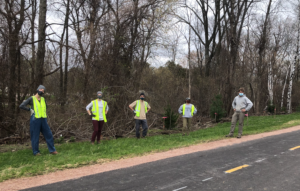
- 33 shrub willows have been planted along the Winooski River by children attending the Burlington Forest Preschool. Why 33? That’s how many children are enrolled at this center, and each kid will get to plant a tree of their own. This is an ongoing partnership and its the second year that the Burlington Forest Preschool has partnered with BPRW to plant trees along the Winooski River.
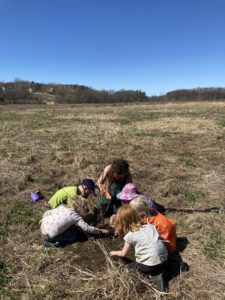
Burlington Forest Preschoolers Plant shrub willow rehomed from 311 North Ave. along the Winooski River.
- 30 trees have found a new home at Lakeview Cemetary. This is part of new energy emerging from the Cemetery Commission to encourage plantings and vegetation maintenance in the cemeteries that help them become a more hospitable place for wildlife, birds, and pollinators.
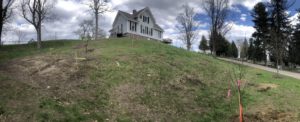
- In the spring of 2020, a group of neighbors in the Old North End on Manhattan drive asked the City if they could plant some fruit trees and shrubs in the greenbelt adjacent to their homes. This small orchard space sparked dialogue between the neighbors and the City, to consider expanding the work to include larger portions of the greenbelt. This project is quickly becoming a lead example of what the City and community members can accomplish in partnership together to combat climate change. The site has received 15 of the rehomed trees, including burr oak, red maple, american chestnut, and witch hazel. Read more about this project.

Perhaps the most significant partnership formed in the quest to save these trees is that between Grow Wild, BPRW, and the Champlain Elementary School. In a mutually beneficial collaboration, Champlain has agreed to home several dozen of the refugee trees. The trees finding a place to live on the Champlain campus is not the singular goal, but the first building block of a multifaceted project that hopes to create and connect wildlife habitat, integrate outdoor learning into Champlain kids’ curriculum, and succeed existing trees that are non native or failing with more suitable replacements.

Behind Champlain, there are two wooded areas that are currently separated by a north-south running field area. This open space presents the opportunity to build a wildlife corridor with native trees and shrubs, right along the fence bordering the east side of the playground. The corridor will be facilitated by Grow Wild, an initiative to promote biodiversity and climate resilience by connecting fragmented wildlife corridors such as those on the Champlain campus. Any wildlife that uses either one of the wooded areas as their home will have a protected passageway to the other wooded area, thus the habitat will be expanded by much more than the actual area that is being re-vegetated.
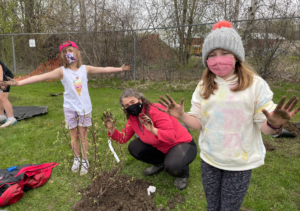
The benefits of the wildlife and shrub corridors go beyond providing habitat for pollinators, birds, and other wildlife, and beyond carbon sequestration and other ecosystem services. This is now an opportunity to enrich elementary age kids’ learning with outdoor, experiential education that will help them understand the importance of protecting natural communities at an early age. Various activities such as mapping, plant identification, biodiversity reporting, and tracking of wildlife and ecological succession all have the potential to be part of the outdoor learning curriculum. This curriculum will be designed to have different activities and lessons for each grade level, with each step up becoming more advanced and integrating the various pieces and processes of the landscape with ecological knowledge, reflection, and social context.

With such ambitious and far reaching goals, it is the hope of project managers that the outcomes of this tree relocation strategy will serve as a pilot for other Burlington schools. The outdoor curriculum will be developed further over the coming years, with an entire unit of the built in science curriculum dedicated to outdoor experiential learning. As teachers and school administrators learn about the most successful and beneficial aspects to teaching about natural communities and processes, among those communities and processes, one goal is for other schools in the area to be able to draw upon the knowledge gained during this experiment.

It is also crucial for this project to serve as an example of the kinds of creative approaches we can take to preserve our natural communities in the face of inevitable future development. We can do so much more to improve the living conditions for us and future generations than what we are limited to by working within the framework of increased urbanization being the only option. As we move forward as a city, it’s worth asking: how are these trees paving the way for better conservation practices for development in Burlington?
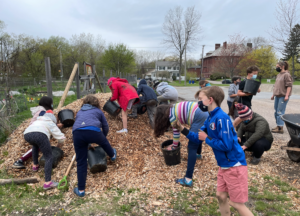
Upgrading the standards for how we treat the land that we want to transform is crucial, and nature based solutions will play a significant role.
